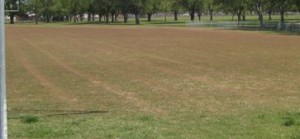(Megan Kennelly, KSU Plant Pathology)
I received this sample today:
Here is the photo that came with it:
What’s going on here? First – what grass is it? This is bermudagrass, one of our warm-season grasses. When we have cold snaps, these grasses can take on a purple-red tinge. The chlorophyll is damaged and the anthocyanins become visible. If you look across a whole field, the red-purple can also have a brown-ish appearance, and that makes people wonder about diseases. But, if you look closer, you’ll see that it is purple. The turf grows out of it once temperatures are warmer.
In many parts of the state our overnight lows dropped into the 30’s last week, so the timing fits the symptoms – that is another important piece.
It’s not quite Wildcat purple. If we could do that, we’d have a nice patent on our hands and we wouldn’t have to worry about our research budgets anymore.
Here are some photos from a couple of years ago showing similar symptoms after a cold snap in early May. In the “long view” shot you can see how it can have a brownish cast, which can cause concern.




